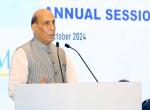Indian Prime Minister Narendra Modi, has left none in doubt that his commitment to the Indian defence self-reliance is “unquestionable and uncompromising”. Modi was right in his criticism of the Defence Research and Development Organisation (DRDO) for its failure to deliver on strategic projects on time. It is in the fitness of things that Modi pulled up DRDO with a suggestion to complete the projects without time and cost escalation. For long DRDO has been in news for its poor handing of projects that paved way for an inordinate delay and steep cost escalation. And in the process, the defence forces of the country were put to a great disadvantage. Not un-often, DRDO also took the blame for the poor quality of the products.
Of course, many of the nationally important defence projects undertaken by DRDO including the fourth generation Light Combat Aircraft(LCA)Tejas, Main Battle Tank(MBT) Arjun and anti tank missile Nag have suffered both time overrun and cost escalation. But then the blame for this pathetic state of affairs need to be shared by armed forces too which have been throwing in the spanner in the smooth progress of the defence projects by forcing the mid course “changes in specifications”. For instance, the developmental cycle of Tejas which is now winging its way towards FOC (Final Operational Clearance) took a hit when the Indian Air Force(IAF) projected the need for a higher thrust power plant while the fighter aircraft development had covered much ground. As things stand now, there is little likelihood of the Tejas fighter entering into the operational service before 2016 though the earlier projected date was 2014. Wondered Modi, “The big challenge is how do we complete our work before time. If the world brings out a weapon in 2020, can we do it by 2018”?
Rightly and appropriately, Modi has highlighted the need for a greater level of interaction between the armed forces and DRDO. Here the best option will be to involve defence forces actively in the projects of DRDO with a commitment to buy the end product. For only such accountability will cut down the cost escalation and delays in the implementation of defence projects. Of course, there is no denying the fact that the biggest handicap nagging the Indian defence sector is the lack of coordination and a growing gap between the DRDO, armed forces and the production agencies. To overcome this, a new strategy need to be evolved. More importantly, the notorious import lobby which has many sympathisers in the military, political and bureaucratic set up of the country should be put in its place, now and here.
Another major prescription of Modi for rejuvenating DRDO is to make way for the younger talent in certain critical areas. “Can you select five laboratories where everybody will be below 35 years in age? Even the decision makers are below 35 years? You need to take a risk and bring in some fresh air,” said Modi. But then the catch is that DRDO is losing its young talent to private enterprises including IT companies and multi nationals which offer a fat pay packet. How to prevent manpower attrition is now a major concern for DRDO. Clearly and apparently, a government owned enterprise like DRDO could hardly match the private sector players in terms of the benefit package offered to the employees. Motivation and professional satisfaction alone cannot by themselves help prevent manpower attrition faced by DRDO.
All said done, it must be said to the credit of DRDO that in recent years it has done exceptionally well especially in terms of developing a range of tactical and strategic missile featuring cutting edge technologies. This achievement assumes significance in the context of the denial of advanced technologies by the industrialised countries including USA.
Clearly and apparently, India should not lag behind China in terms of grabbing a share of the global business in arms and armaments. Against this backdrop, DRDO should disentangle itself from the business of production—which Indian industry cutting across the public-private sector distinction can take care of—to concentrate on the higher end research and development which is vital for the development of advanced defence technologies. For quite some time now, Indian Space Research Organisation (ISRO)has been active in roping in the Indian industry and groom it to take over the role of the producing the fully integrated satellites and launch vehicles. For such a strategy would help the Indian space agency to focus exclusively on research and development to sustain India’s leadership position in space exploration.
With India all poised to emerge as an economic and technological power of the global standing ,the country would need to position itself as a resurgent military industrial hub capable of producing a range of smart defence equipment that will easily capture the imagination of buyers from across the world. In this context, the transfer of technology in India’s official defence procurement procedure need to be exploited to the hilt to derive maximum advantage to sharpen the technological base of the Indian defence production matrix. Indeed, Modi’s dictum that only a strong nation commands respect needs to be taken seriously. During one of his election meetings at Rewari in Haryana, where a large number of ex servicemen had gathered, Modi had invoked the spirit of Bhagwad Gita that exhorts one not to run away from the battlefield and instead lead the battle from the front. This logic could also be interpreted as an exhortation for achieving strategic self-reliance that could help India command global respect and admiration.
While importing arms and defence hardware till such time as India attains total self reliance in defence production, India should look beyond seller buyer relationship by insisting on technology transfer as part of the deal. As it is, all the defence acquisition deals should be seen as a pathway towards attaining self reliance in defence production through the acquisition of new and innovative technologies. With the scams and scandals becoming the order of the day during the last one decade of the UPA (mis)rule, the acquisition of defence hardware needed badly by Indian defence forces had come to a virtual standstill. As such the Modi Government should pick up the thread and fast track the process of arms acquisition on a priority basis. A culture of speed, transparency and efficiency should be the hall mark of the Indian defence procurement program. The depressed spirits of the Indian armed forces that had to pay a heavy price for the indecision of the former Defence Minister need to be lifted without any loss of time. It is here that the Modi Government can play a positive role.
Modi’s philosophy that a powerful defence force is the best deterrent against wars does not need to be overemphasised. While commissioning India’s biggest ever home grown warship INS Kolkatta Narendra Modi said “INS Kolkatta is an example of our military might, showcasing our capabilities to the world. In today’s world, fighting and winning wars is less difficult. To ensure that there is no war; one has to have a modernised and powerful military coupled with state of the art weaponry so that no one can dare cast their evil eyes on us”. The ruling dispensation in New Delhi should also put in place a holistic policy to ensure the capabilities of the Indian defence industry are fully well harnessed to speed up the process of a self reliant defence production.
The recent decision of the Indian Government to increase FDI(Foreign Direct Investment) cap in the Indian defence sector to 49% from the earlier 26% along with the introduction of pro active measures to attract the Indian private sector to the Indian defence production is expected to introduce a spirit of motivation in the Indian defence sector. Modi’s own view is that FDI hike was undertaken with a two-fold agenda—to turn India self reliant in defence production and facilitate the export of made in India defence hardware. “We have invited global players to set up their facilities here, so that we do not have to import each little defence hardware. There will come a day when we would be in a position to export the same equipment we are importing now. This will also be beneficial to the nation” said Modi.
Of course, DRDO on its part has made it clear that there is a huge potential for the export of defence equipment including the fighter aircraft. “We have a list of equipment that includes LCA Tejas, Akash air defence system, Prahar class of missiles, Indo-Russian supersonic cruise missile BrahMos along with a number of other systems that can be exported,” said DRDO chief, Avinash Chander. But then in the absence of a policy framework and suitable guidelines, DRDO will not be in a position to go ahead with the proposed export. It is here that Indian Government should play a positive role in the endeavour of positioning India as an exporter of defence hardware.
That India continues to be the largest importer of arms, ammunition and a range of fighting equipment including combat aircraft reflects poorly on the standing of the nation that has sent probes to moon and Mars and has built a nuclear powered submarine. The grim ground reality is that two third of the Indian defence requirements is met through imports. Lack of creativity and long term vision, a shoddy work culture, bureaucratic interference along with the devious doings of a powerful import lobby did go to sap the vitality of DRDO in terms of expanding the frontiers of self reliance in defence development. Way back in 2007, a committee headed by P. Rama Rao, a former head of the Department of Science and Technology(DST) had suggested the restructuring of DRDO. But then DRDO is yet to reposition itself as a vibrant and forwarding looking hub of defence research and development with a particular thrust on meeting the needs of the Indian defence forces speedily and efficiently.
A doer and accomplisher, Modi has clearly shown that he means business. For within the weeks of assuming power, Modi saw to it that defence self reliance is set in motion through a slew of measures including hike in FDI cap in defence production , pro active measures to support private industry participation in defence production and an increase in defence spending. The response of the Indian industry to Modi government’s line of action in the area of defence production has been quite positive. “We really expect quicker implementation. There are signs that this government is very keen to grow indigenisation” said MV Kotwal , President(heavy engineering) of the heavy engineering firm Larsen and Toubro(L&T) .L&T is targeting a four-fold increase in annual defence revenue to US$ one billion over the next five years. Similarly, Tata Group, another leading player in India’s defence production sector, has also shown its keenness to enhance its investment in defence production
Meanwhile, Avinash Chander has made it clear that it is planned to achieve 75% indigenisation in defence production between 2020 and 2025. In this context, he said several steps have been initiated to bring down the level of defence import. “An analysis of approvals given by the government during last seven years show that more than 50% procurement was indigenous .Our self reliance index is definitely more than 50%” he said. But the DRDO cannot rest on its laurels. It should take the advice of Modi seriously and go about the business of turning India into a thriving hub of defence production in a systematic and time bound manner.
But then way ahead in the task of attaining defence self reliance and transforming India into a major defence exporter is strewn with difficulties and challenges. Transforming DRDO into a vibrant hub of research and development with a focus on cutting edge technologies, reducing the time lag between the development of technology and its conversion into a specific product, involving the defence forces actively in the quest of attaining defence self reliance and encouraging and incentivizing the Indian industry cutting across private-public sector distinction are some of the positive measures that need to be taken to build up a vibrant, world class Indian military industrial complex.
Published Date: 5th January 2015, Image Source: http://indiatoday.intoday.in








Post new comment